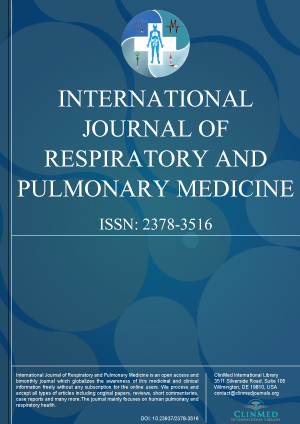Open Access DOI:10.23937/2378-3516/1410152
Efficacy of Initial Large-Volume Thoracentesis for Malignant Pleural Effusions
Victor E Prado, MD, Shasha X Chen, MD, Shashvat Sukhal, MD, Sean B Smith, MD and Sanjay A Patel, MD
Article Type: Research Article | First Published: March 31, 2021
Large malignant pleural effusions (MPE) are common and can cause respiratory distress. Large-volume thoracentesis (LVT) is the most readily available initial procedure, but its efficacy for large MPE with acute respiratory symptoms is unknown. We reviewed LVT for MPE causing ≥ 50% opacification of the hemithorax who presented with acute respiratory symptoms. LVT was defined as draining ≥ 1.5 liters (L). We catalogued volume removed and percent opacification of the hemithorax after LVT in ord...
Open Access DOI:10.23937/2378-3516/1410151
Extensive Pneumomediastinum in COVID-19 Pneumonia
Adetiloye Oluwabusayo Adebola, MD, Beketova Tatyana, MD, Williams Tabatha, NP and Agarwal Sanket, MD
Article Type: Case Report | First Published: March 31, 2021
Pneumomediastinum, defined as the presence of air in the mediastinum often occurs due to trauma, mechanical ventilation or surgical procedure. It may also occur spontaneously due to predisposing lung diseases such as asthma and Chronic obstructive pulmonary airway disease (COPD). In this report, we present a case of a patient with COVID-19 pneumonia without any underlying lung conditions or usual risk factors for pneumomediastinum who developed extensive pneumomediastinum with pneumopericardium ...
Open Access DOI:10.23937/2378-3516/1410150
Incidence of Post-Procedural COVID-19 at an Urban Academic Medical Center during High Prevalence Months
Joanne Szewczyk, MD, Dao M Nguyen, MD, MSc, Prem R Warde, MSIE, Bhavarth Shukla, MD, MPH, Tanira Ferreira, MD, Dipen J Parekh, MD and Hayley B Gershengorn, MD
Article Type: Research Article | First Published: March 31, 2021
In the beginning of the pandemic, after elective procedures resumed in Florida, we tested all patients for COVID-19, nasal pharyngeal swab PCR 72 hrs prior to any procedure. We conducted a retrospective cohort to see the incidence of COVID-19 post-procedural. We conducted a retrospective cohort study of all adult cases of same day or hospital-based procedures at the University of Miami Hospital and Clinics from April 1-September 23, 2020 who were COVID-19-negative (by SARS-CoV-2 polymerase chain...
Open Access DOI:10.23937/2378-3516/1410149
Etiology of Pleural Effusion among Adults in Three University Hospitals in Beirut: A One-Year Retrospective Cross Sectional Analytical Study
Ali IBRAHIM, Amrou RIDA, Ibrahim MALASS and Loubna Tayara
Article Type: Research Article | First Published: March 31, 2021
Pleural effusion, the pathological accumulation of fluid in the pleural space, is very common. It has a wide differential diagnosis, and a delayed etiological diagnosis can be associated with markedly higher morbidity and mortality. It is divided into two main types: Transudative and Exudative, depending on the mechanism of fluid accumulation. The most common causes of pleural effusion are: Congestive heart failure, infections, malignancy, liver and kidney failure. Thoracentesis may be indicated...

